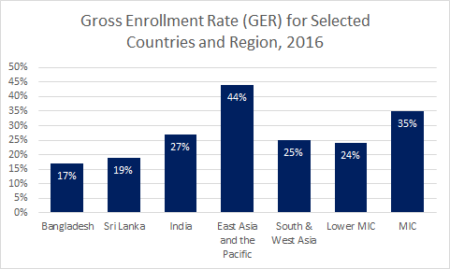GET IN TOUCH
- Please wait...

Despite massive strides in achieving admirable standards across a host of different socio-economic indicators such as infant mortality rates and gender parity in both primary and secondary education, Bangladesh still has a plethora of obstacles it needs to overcome in the tertiary education sector.[1][5] With the modern economy advancing at its current pace and automation ominously looming over the horizon, the need for quality tertiary education has never been more pronounced.
As a whole, the tertiary education sector in Bangladesh is failing to equip graduates with the skillsets current employers are demanding.[3] This “employer-skillset mismatch” translates itself into high levels of graduate unemployment. According to a recent study by the Bangladesh Institute of Development Studies (BIDS), graduate unemployment stood at 38.[6] percent.[2] “Credential Inflation”, a phenomenon where jobs that previously did not require graduate degrees but now do, is further fueling demand for tertiary education but does nothing to address the problem of equipping graduates with the appropriate skillsets.[6] Despite this upsurge in demand, there exist depressing disparities in tertiary education attendance between the two genders as well as people from different economic backgrounds.[1]
There are 4 major pillars upon which the current problems of Bangladesh’s tertiary education sector rests.

The problems of tertiary education will have to be tackled with a robust set of institutional reforms and policy directives. Some constructive suggestions to the problem are as follows:
Successfully achieving the 17 Sustainable Development Goals hinges greatly on the quality of tertiary education prevalent in the country. Goal 4 (Quality Education), Goal 5 (Gender Equality, Goal 8 (Decent Work and Economic Growth) and Goal 10 (Industry, Innovation, and Infrastructure) all directly depend on the state of tertiary education within a developing country. If the tertiary education sector fails to rise up to the challenges of the day, the projected development of the country across various sectors and industries will begin to face severe bottlenecks. Addressing the structural problems of the tertiary education sector will go a long towards creating a more knowledge-driven, skills-oriented and equitable economy.
Our experts can help you solve your unique challenges
Stay up-to-date with our Thought Leadership and Insights